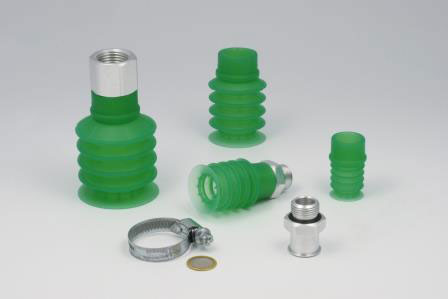
Vacuum cups, or suction cups, are often used as grippers in manual or automated handling applications. They can secure and help move a wide range of products—everything from bottles and bags to bricks and wooden boards, and sheet metal, pipes and glass windows. In essence, they’re the interface between a vacuum system and the workpiece.
Typical vacuum handling systems are a mainstay in many industries, including packaging, food, beverage, woodworking, metalworking, automotive, semiconductor and electronics. Vacuum cups hold several advantages in such applications, including the fact that they are relatively simple, compact, light, and inexpensive and require little maintenance. They are capable of firmly gripping parts in high-speed motion applications, as well as providing gentle handling of fragile parts. Here are some basics on how they work.
Technically, a suction cup does not attach itself and grip the surface of a product. Instead, when a suction cup contacts the workpiece surface, it activates a vacuum generator (such as a vacuum ejector, blower or pump) and draws out air from the cup interior and creates a vacuum. Given that air pressure inside is then lower than that outside of the cup, atmospheric pressure holds the workpiece against the cup. The greater the difference between ambient pressure and vacuum pressure inside the cup, or the larger the effective area of the cup acting on the workpiece, the greater the holding force pressing the cup onto the workpiece.

Ideally, a suction cup should mate against a smooth, nonporous surface. Then, when generating vacuum, the cup rim completely seals against atmospheric air and the interior air is quickly evacuated, resulting in a firm grip on the workpiece. However, non-ideal conditions are many times the norm because materials are often permeable, rough or uneven. In these cases, the cups cannot completely seal and outside air constantly enters the system. That’s termed a leaking system. Designers must compensate for leaking systems by using high-flow vacuum generators or using smaller cups to reduce the potential for leaks.
Types of suction cups range from simple, circular types to those designed for special applications like handling candy, greasy sheet-metal panels, or porous wood and cardboard. They come in two general shapes, flat and bellows.
Flat suction cups are suited for handling workpieces with flat or slightly curved surfaces, such as metal and glass plates, plastic sheets and wooden boards. Flat cups have a small inner volume and, thus, evacuate quickly and can grip in a very short time. Properly designed, they have good stability to handle high shear forces and can withstand forces and accelerations from fast automated-handling movements.
Bellows suction cups, other the other hand, have one or more accordion-like convolutions. This lets them compensate for varying workpiece heights and handle parts with uneven surfaces. Evacuating the bellows also creates a lifting action which can be useful to lightly grip fragile parts, like electronic parts or even chocolate candy.
Bellows versions are typically used for handling curved parts like car body panels, pipes and tubes, injected molded plastic parts, and nonrigid packaged goods or shrink-wrapped products.
Both types come in a number of shapes, including round and oval. Various sizes make them suited for handling products weighing from a fraction of an ounce to several pounds. And they come in many different rubber and elastomer materials to suit specific application requirements, from FDA compliant cups for handling food, abrasive-resistant materials for moving bricks to oil-resistant types in metalworking operations.

can we use vacuum cups to hold pipes and tubes
Hi what are the common suction cups issues that may happen when using vacuum/suction cups?
Does this rubber suction cups will not leave circular tool marks on top surface?
Especially on a high temp soak? (125’C)
thanks
Can these vacuum cups resist any wrenching moment?